
The Grand Canal is a channel in Venice, Italy. It forms one of the major water-traffic corridors in the city.
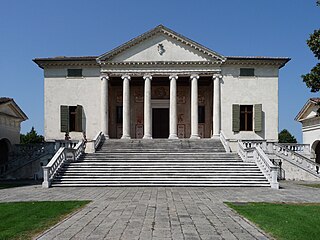
Villa Badoer is a villa in Fratta Polesine in the Veneto region of northern Italy. It was designed in 1556 by Italian Renaissance architect Andrea Palladio for the Venetian noble Francesco Badoer, and built between 1557 and 1563 on the site of a medieval castle, which guarded a bridge across a navigable canal. This was the first time Palladio used his fully developed temple pediment in the façade of a villa.
Caldogno is a town and comune near Vicenza in Italy. It has a population of 11,337 inhabitants.

Caerano di San Marco, or simply Caerano, is a town with 7,813 inhabitants in the province of Treviso.
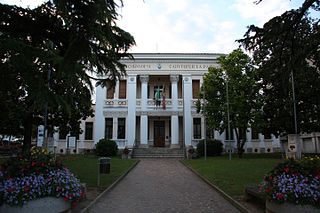
Cornuda is a comune with 6,325 inhabitants in the province of Treviso.

Crocetta del Montello, formerly Crocetta Trevigiana, is a comune (municipality) in the Province of Treviso in the Italian region Veneto, located about 50 kilometres (31 mi) northwest of Venice and about 25 kilometres (16 mi) northwest of Treviso. As of 31 December 2004, it had a population of 5,807 and an area of 26.4 square kilometres (10.2 sq mi).

Villa Molin is a patrician residence in the neighborhood of Mandria, in Ponte della Cagna, south of Padua, in the Veneto region of northern Italy. It was designed for Nicolò Molin, a Venetian noble, by Vincenzo Scamozzi and completed in 1597. It faces Mandriola, on the opposite side of the Canale di Battaglia. The original agricultural setting of the villa, composed of pasture and orchards, has given way to a residential dormitory community of Padua.

The House of Loredan is a Venetian noble family of supposed ancient Roman origin, which has played a significant role in shaping the history of the entire Mediterranean. A political dynasty, the family has throughout the centuries produced a number of famous personalities: doges, statesmen, magnates, financiers, diplomats, procurators, military commanders, naval captains, church dignitaries, writers, and lawyers.

Ca' Farsetti is a palace in Venice, Italy. It is located in the sestiere (district) of San Marco, and faces the Grand Canal, not far from the Ponte di Rialto. The neighboring building is Palazzo Cavalli.

Ca' Loredan is a 13th-century Romanesque-style former palace of the Loredan family located on the Grand Canal in Venice, northern Italy. It is located in the sestiere (district) of San Marco and faces the Grand Canal, not far from the Rialto Bridge. Together with the annexed Ca' Farsetti, it is currently home to the city's municipal council.

Villa Contarini, also known as Vigna Contarena, is a villa in Este, Province of Padua, in the Veneto region of northern Italy. The name Vigna Contarena seems to come from the fruit trees and vines originally cultivated in the park of the villa, situated at the foot of the Euganean Hills. The villa was built in the first years of the 17th century and served both residential and agricultural purposes, with the ground floor destined for storage and labor uses, while the first floor, or piano nobile, contained the living quarters and formal rooms.
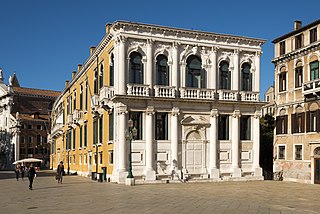
The Palazzo Loredan at Campo Santo Stefano is a palace in the San Marco district of Venice, overlooking Campo Santo Stefano. Before the acquisition by the Loredan family in 1536 and the restoration by the architect Antonio Abbondi, it was a group of adjacent buildings, in the Gothic style, belonging to the Mocenigo family. The purchased buildings were substantially restored and made into a single building for the residence of the wealthy noble family of Loredan. The palace has throughout history been home to at least seven Doges of Venice.

Villa Spineda Gasparini Loredan is an 18th-century Palladian style villa of the noble Loredan family located in the town of Volpago del Montello in the Veneto region of northeast Italy. It is regarded as one of the most beautiful villas of the Veneto.

The Villa Loredan at Stra is an early 16th-century villa of the noble Loredan family located in the town of Stra, on the Brenta river in the Veneto region of northeast Italy.

The House of Marcello is a noble family of Venice, once ascribed to the Venetian Patriciate.
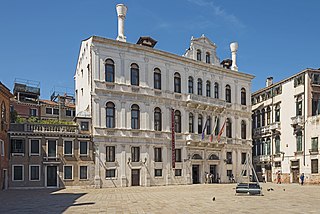
Palazzo Priuli Ruzzini Loredan, also called Palazzo Loredan at Campo Santa Maria Formosa, is a late 16th-century palace located at Campo Santa Maria Formosa in the Castello district of Venice, northern Italy, characterised by features of Renaissance and Baroque-style architecture on its façades.

The Villa Loredan at Carbonera, also known as Villa Loredan Valier Perocco, is a 17th-century aristocratic villa located in Vascon, a district of Carbonera in the northern Italian region of Veneto.

Dating to the beginning of the 15th century, Villa Dal Verme is one of the few Venetian villas of that period that has survived until the 21st century without excessive modifications in the exterior. The building is located just outside Agugliaro, not far from the road to Vò on the Liona canal and is sometimes referred to as "the mother of all Venetian villas."
Villa Garzoni is a villa in the Veneto region designed by Jacopo Sansovino around 1540 in Pontecasale, a hamlet in the municipality of Candiana, in the province of Padua.
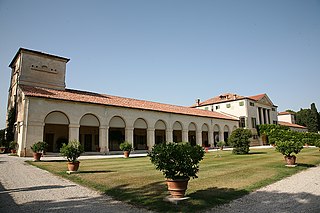
A barchessa is a rural service building, typical of the architecture of Venetian villas. The concept was created and popularized by architect Andrea Palladio. A barchessa contains the working portions of the estate, separately from the central body of the villa. Barchessas were characterized by a long arcade with high round arches and used for services including kitchens, farm staff, stables, and barns. As interpreted outside of Italy, the barchessas evolved to become defining elements of Palladian architecture.




















